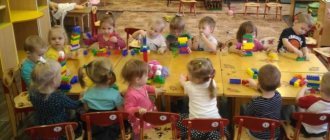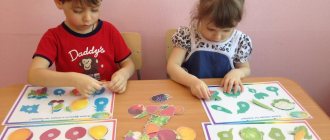Logic problems for older preschool children
Valentina Rozhkova
Logic problems for older preschool children
September. 1 year of study.
Week 1: - Think and decide: Who will swim to the shore faster - a duck or chickens?
— What is the best and fastest way to pick a watermelon from a tree? (watermelon does not grow on a tree)
.
2nd week:
— There were children's books on the shelf. The dog ran up, took one book, then another, then two more. How many books will she read? (Not at all. Dogs can't read)
— There are 3 branches on the oak tree, on each branch there are 3 apples. How many apples are there in total? (Apples do not grow on oak trees.)
3rd week:
- Who will reach the flower faster - a butterfly or a caterpillar?
— There were 3 carrots and 4 apples in the plate. How many fruits were in the plate? (4 apples. Carrots are not a fruit, but a vegetable)
-The cat Murka gave birth to puppies: one black and two white. How many puppies does Murka have? (None. The cat has kittens.)
Week 4: - Who is the eldest ? Who's the shortest? Who is taller - father or mother? Who is older than you ? Who is taller than you, but shorter than mom?
— Three sparrows sat on the water. One flew away. How much is left? (sparrows do not sit on water)
.
— A multi-colored wheel is rolling: one corner is red, the other is green, the third is yellow. When the wheel reaches the edge of the table, what color will be visible? (None. The wheel has no corners)
October. 1st year of study.
1st week.
— On the shelf were: a pyramid, a tumbler, a teapot and a doll. How many toys are on the shelf? (Three. A teapot is a tableware)
.
- How many ends does a stick have? Two sticks?
2nd week:
— A rooster and a hen were walking around the yard. A rooster has two legs, and a chicken has four.
How many feet were walking around the yard? (-The chicken has 2 legs, not four)
.
— How many chickens did the rooster hatch if he laid 5 eggs?
(Not at all. Roosters don't lay eggs)
- Who will moo louder - a rooster or a cow? (Roosters don't moo)
3rd week:
— Marina and Tanya drank different juices - apple and grape. Marina did not drink apple juice. What juice did Tanya drink?
— Katya and Lena painted with paints and pencils. Katya did not draw with paints. What did Lena draw with?
— Mom has a cat Fluff, a daughter Dasha and a dog Sharik. How many children does mom have ?
4th week:
— Kostya and Artem were dressed in jackets of different colors: blue and green. Kostya was not wearing a blue jacket. What color jacket was Artem wearing?
— One banana falls from the tree every minute. How many of them will fall in 5 minutes?
November. 1st year of study.
1st week.
— How to use two sticks to form a square on the table?
- Grandma has a granddaughter Masha, a cat Fluff, and a dog Druzhok. How many grandchildren does grandma have?
2nd week:
— How to form a triangle on the table using only one stick?
— The cat Vaska and his owner are sitting in a boat. The owner throws out a fishing rod and says: “Catch, fish, big - very big.”
.And Vaska quietly mutters:
“Little catch, little one
. Why did he say that?
3rd week:
- I bought it for one ruble, paid two rubles. How much change will they give?
— Ping the penguin felt cold and jumped up 6 times to warm up. His brother Gwin also decided to warm up and jumped 4 times. Who was colder: Pin or Gwin?
4th week:
- You, me, you and me. How many of us are there?
Educational games for children 5 – 6 years old by goal groups
| Target | Game name |
| Fine motor skills training | 1. Stringing |
| 2. Coloring | |
| 3. Origami | |
| 4. Shadow theater | |
| 5. Sort out the cereal | |
| Development of attention | 1. What has changed? |
| 2. What to do? | |
| 3. Claps | |
| 4 Elements | |
| 5. Guess the toy | |
| Development of logical thinking | 1. Drawings from geometric shapes |
| 2. Endings | |
| 3. Fill in the circle | |
| 4. Good - bad | |
| 5. What happens? | |
| Speech development | 1. Complete the sentence |
| 2. Daily routine | |
| 3. Who eats this? | |
| 4. 3 words | |
| 5. What was what? | |
| Numeracy skills | 1. Where is the ball? |
| 2. Forward and backward counting | |
| 3. Feed the animal | |
| 4. Measurements | |
| 5. Cards with numbers |
Games to develop fine motor skills
Since the initial development of relevant skills has already been established at this age, the following games will help further improve fine motor skills in older preschoolers:
- Stringing. You can string beads, rings, buttons, pasta and other items. You will also need fishing line or strong thread. You can hold a “fair” where beads, bracelets and other jewelry made by the children will be presented.
- Coloring. The game is held in the form of a coloring master class or competition. Children are given pictures with outlines of shapes and explained how to hatch. Pictures need to be painted in straight and diagonal directions.
- Origami. Children are given paper and explained how to fold the figures. Then you can offer to organize a competition or play paper toy store.
- Shadow play. Turn off the lights in the room and point the light source at the screen (from a distance of approximately 4 m). Children are shown how to use hand movements between a light source and a screen to create pictures on the screen. You can act out scenes with shadow characters.
- We sort through the cereal. For this game you need to mix 2 types of cereals (for example, buckwheat and rice or millet) and ask the child to help sort the cereal into their jars. Subsequently, the task can be complicated by adding 1 or 2 more types of cereals.
Experts believe that the development of fine motor skills is directly related to the development of speech and intelligence in general.
E. O. Komarovsky
Pediatrician, Ph.D.
Working with your fingers affects the speech areas of the brain. It is necessary to begin developing fine motor skills from six months to 6 years. As a result, speech is formed correctly, memory and imagination are stimulated.
— E. O. Komarovsky Pediatrician, Ph.D.
Games to develop attention
The following games will help your child learn to acquire, accumulate and apply new knowledge:
- What changed? Up to 7 (but not less than 3) different toys are placed in front of the child. At a signal, the child closes his eyes, and the adult removes one of the toys. Then, again at a signal, the child must open his eyes and guess which toy is missing.
- What to do? Before the game starts, children are explained what action to perform when naming a particular word. Then the children walk in a circle, and the leader calls out any of the previously discussed words. In this case, players must perform a certain action (for example, “stork” - stand on one leg, “crawfish” - walk backwards, “hare” - jump, etc.).
- Claps. This is a game similar to the previous one. Only instead of a word, children must perform a certain action for a pre-agreed number of claps. So, for example, 1 clap can mean “stork”, 2 – “crayfish”, 3 – “hare”, etc.).
- Elements. Children sit in a circle. When the leader names a certain element, they must perform a pre-agreed action (for example, “water” - lower your arms, “fire” - raise, “air” - spread your arms to the sides, “earth” - cross your chest).
- Guess the toy. The child needs to depict some actions that would characterize the proposed toys (for example, show how a bear, a fox, etc. behaves).
Julia
In pedagogical activity, one of the main directions is the development of attention, since the quality of teaching will depend on it in the future.
- Julia
Games to develop logical thinking
Logical thinking skills are necessary as preparation for further education. The following games will help develop the ability to think logically:
- Drawing of geometric shapes. Children are given various geometric shapes drawn on a piece of paper. The guys must draw an object or character from the resulting geometric figure (for example, an apple from a ball, etc.).
- Endings. Children are asked to complete sentences like: “Masha left the house before Vera, which means Vera is ... (later Masha).”
- Fill in the circle. Children are given sheets of paper with 6 circles drawn several times and are asked to paint them in such a way that there are as many filled circles as unfilled ones. The one who offers the most shading options will win.
- Good bad. The child is asked to analyze any phenomenon from all sides, paying attention to positive and negative aspects, for example: “A lot of mosquitoes are bad, they bite, but it’s good that the birds have something to eat. There are no mosquitoes - it’s good, but the bad thing is that the birds have nothing to eat, they will fly to other places and there will be a lot of mosquitoes.”
- What happens? Children are encouraged to ask each other questions and take turns answering, for example: “What is white? (cloud, towel, etc.)” “What is big? (joy, car, mountain, etc.).”
Elena
Orenburg
A child’s logical thinking needs to be developed systematically and in a timely manner, so that in the future he can study well and achieve his goals.
— Elena Orenburg
Speech development games
Speech development is an important stage of learning; the following games will help with this, by the way, closely related to the previous group of logic lessons:
- End of sentence. Children are asked to complete the sentences based on the context (Vita didn’t come today because ... (sick); dad brought ice cream and put ... (in the refrigerator); Marina is going to the store to ... (buy groceries)).
- Daily regime. Children are shown pictures of different activities during the day. The children are asked to place them in the correct order.
- Who eats this? Pictures depicting various animals are given, and it is asked to determine which of them should be given, for example, grain, honey, apples, grass, etc.
- 3 words. Children are asked to name 3 words as an answer to one question, for example: “What can you cook? (egg, meat, pasta).”
- What was what? The presenter asks questions like: “Who used to be a chicken, a butterfly, a horse?”, “What used to be bread, a sweater, a table?”, and the children need to answer them.
A. N. Leontiev
Soviet psychologist, author of the general psychological theory of activity
Speech occupies a central place in mental development, the process of its development is development itself.
— A. N. Leontyev Soviet psychologist, author of the general psychological theory of activity

